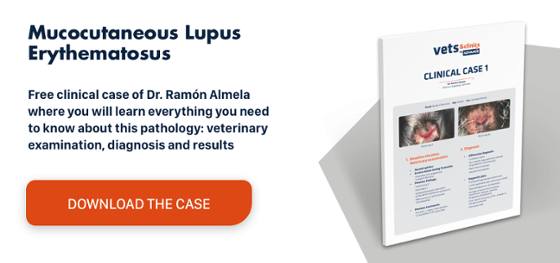Ringworm in dogs or canine dermatophytosis. Different detection techniques
What is ringworm in dogs and what are the clinical signs?
Dermatophytosis, commonly known as ringworm, is a skin infection caused by fungi from the genera Microsporum, Trichophyton and Epidermophyton spp., although Microsporum canis is the main causal agent of ringworm infections in cats.
Ringworm is a common, contagious zoonotic disease that is more frequent in cats than dogs. It is commonly found in animals living in groups, so it is important to detect and treat it as early as possible in order to avoid infection.
The clinical signs of ringworm in dogs are visible between 2 and 4 weeks after becoming infected, but it spreads more quickly in immunocompromised patients. It courses with either localised or generalised circular lesions accompanied by alopecia. Ringworm in dogs does not cause pruritus, unlike in humans, so there tends to be fewer lesions due to scratching.
An early diagnosis is important to avoid the need for aggressive treatment. It is sometimes enough to improve the affected animal’s immune system, thus stopping the fungus from spreading. A topical fungicidal ointment, powder or lotion is usually applied over the patient’s entire body. A systemic antifungal is used in more advanced, severer cases.
Ringworm in dogs: diagnostic techniques
Its clinical presentations include nodular dermatophytosis (kerion), which is a localised infection in the dermis.
Of the various diagnostic tools some can produce false-negative results, such as the Wood’s lamp, microscopic examination of hairs to detect fungal elements and fungal cultures. In these cases, histology with specific immunostaining should be employed.
To this end, a descriptive study1 published in 2009 looked at 23 dogs of different breeds, age and sex affected by nodular dermatophytosis with one or more nodules.
They obtained a negative result with the Wood’s lamp for all subjects in the sample. The highest number of positive results (21 cases, 91%) were with impression smears, evidencing arthrospores in hair fragments or in a free form among neutrophils and macrophages (pyogranulomatous inflammation), with histology performed in two subjects. The authors reported that 12 skin scrapings in mineral oil were positive for arthrospores and/or hyphae, with a microscopic hair examination revealing arthrospores in 8 subjects. The fungal culture was positive for Microsporum canis in 16 dogs and for Microsporum gypseum in 1 dog, while 6 cases were not identified by a culture.
As for the patients’ treatment, all subjects were given systemic antifungals, which was combined with antibiotic therapy in 8 patients, and the nodular dermatophytosis resolved in all cases within 4–8 weeks


